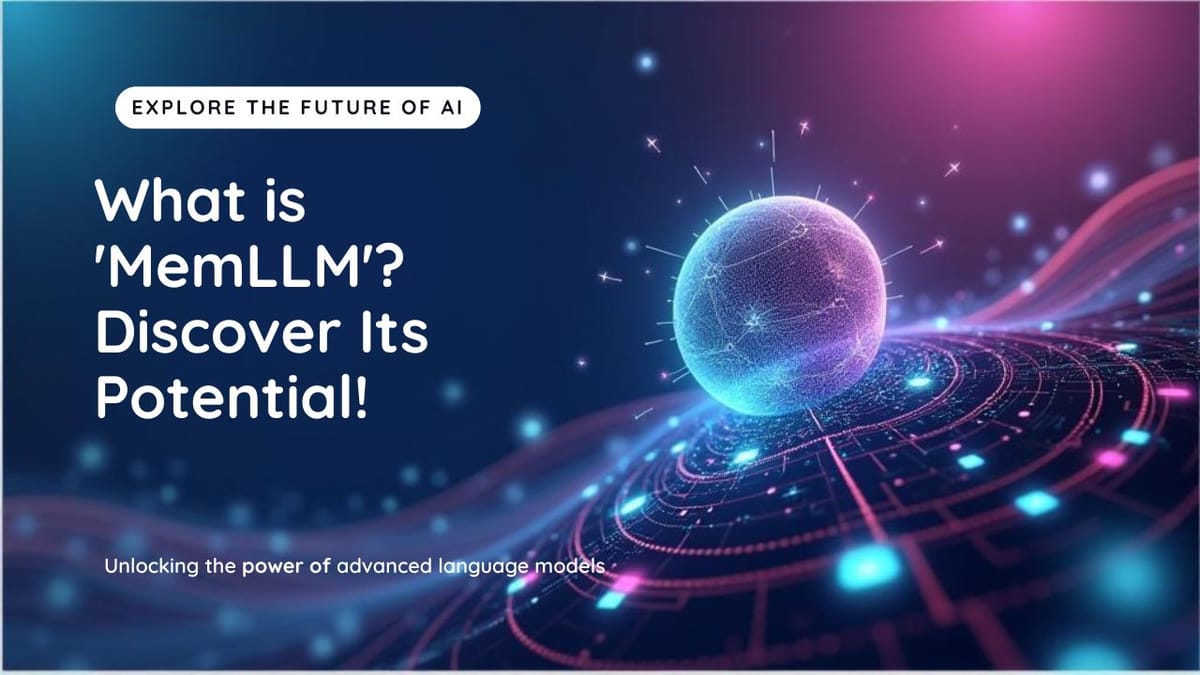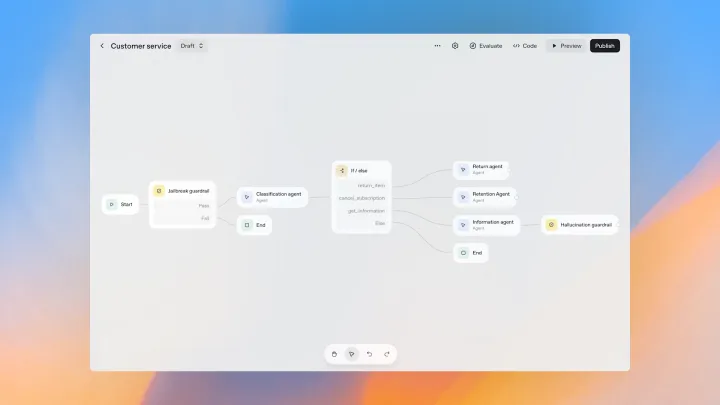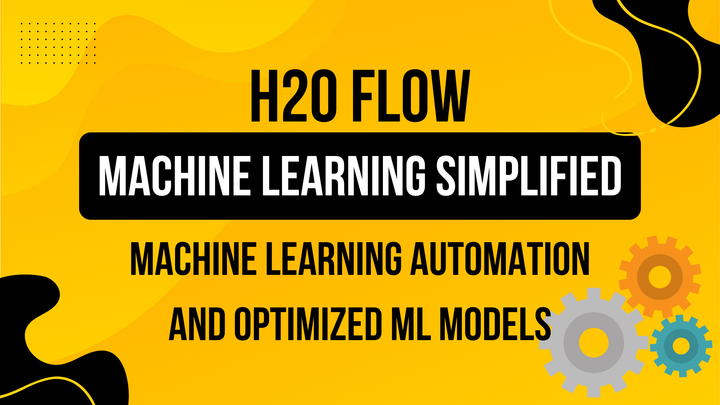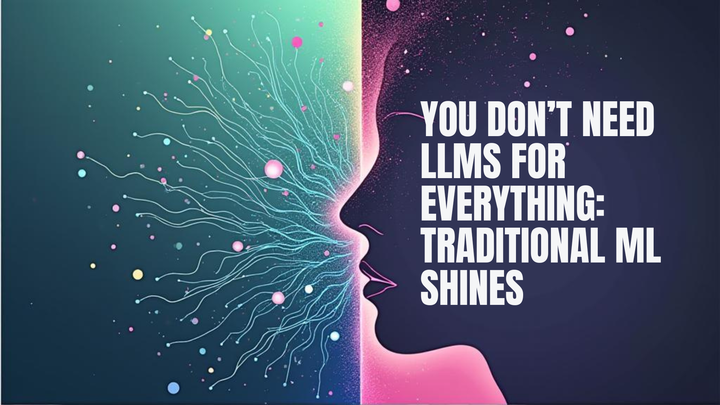What is "MemLLM"? A Comprehensive Guide to Memory-Augmented Large Language Models

What is "MemLLM"? In short, "MemLLM" refers to a novel approach in artificial intelligence that augments large language models (LLMs) with an explicit, structured read-write memory module. Unlike traditional LLMs, which store knowledge only within their neural network parameters, MemLLM endows models with a dedicated, interpretable memory system, enabling dynamic storage and retrieval of facts and relationships. This architecture improves the model's capability in knowledge-intensive tasks, reduces hallucination, and greatly enhances transparency and factuality by making memories accessible, editable, and inspectable during inference.
Introduction: The Need for Explicit Memory in LLMs
Traditional large language models like GPT-4, Mistral-7B, or Llama-2 store their acquired knowledge implicitly within their billions of parameters. While this enables impressive generation capabilities, it presents critical limitations: the inability to easily update, inspect, or edit their knowledge; difficulty retaining infrequent facts or recent changes; and a proneness to generating plausible-sounding but incorrect ("hallucinated") statements, especially in knowledge-intensive scenarios.
MemLLM—introduced and formalized in the 2024 research paper "MemLLM: Finetuning LLMs to Use An Explicit Read-Write Memory"—addresses these issues by providing LLMs with a separate, explicit memory structure which can be both read from and written to programmatically during model operation. This additional memory layer acts akin to a knowledge database, bridging the gap between parameter-centric models and techniques such as Retrieval-Augmented Generation (RAG), while offering interpretability and updateability that previous LLM architectures could not match.
Definition and Concept of MemLLM
At its core, MemLLM is a framework for augmenting large language models (LLMs) with a structured, explicit memory module. This module enables the LLM to perform read and write operations on a dynamic knowledge base containing information in the format of subject-relation-object triples, similar to a knowledge graph.
Key distinctions from traditional LLM architectures include:
- Explicit Non-Parametric Memory: Information is stored and indexed outside the model's weights, making the memory:
- Dynamic — can be updated at runtime.
- Transparent — can be inspected, debugged, and edited directly by users or developers.
- Structured — stored as interpretable relationships rather than opaque vectors.
- API-Based Access: The LLM interacts with this explicit memory via formalized API calls (e.g.,
MEM_READ,MEM_WRITE), which are trained during the fine-tuning process.
In contrast to both:
- Parametric memory: which resides inside model weights (and thus cannot be easily edited or attributed),
- And traditional RAG: which retrieves chunks of unstructured text for augmentation, but lacks compositional structure and precise editability,
MemLLM’s explicit memory allows querying, updating, and precise control over factual knowledge within an LLM-powered system.
Technical Architecture of MemLLM Memory Module
Core Structure
MemLLM's explicit memory is realized as a structured table of subject-relation-object triples (e.g., ⟨Washington D.C., capital of, United States⟩), plus embedding indices for efficient retrieval:
| Table | Contents | Indexing Method |
|---|---|---|
| Triple Memory | (Entity1, Relation, Entity2), plus unique IDs | Indexed by all triplet keys |
| Entity Table | ID, name, vector embedding | Indexed by entity name & embedding |
| Relation Table | ID, name, vector embedding | Indexed by relation name & embedding |
This design enables:
- Deduplication and normalization (e.g., “US” ~ “USA” via embedding similarity)
- Efficient querying: using partial queries (e.g., “capital of X”) resolved via vector similarity rather than exact match
Memory Controller
At the system level, a Memory Controller manages all storage and retrieval operations. It provides:
- Embedding functions: using models like Contriever, each entity/relation is embedded as a vector for efficient similarity search.
- HNSW indices: for scalable nearest-neighbor search over entities and relations
- Query interface: for finding candidate entities and relations matching a given query, permitting flexible access patterns.
Memory operations are protocolized using special tokens. For instance:
Reading from memory (e.g., fetching all capitals):
({MEM_READ(Washington D.C.>>capital of>>)--> United States})
Writing to memory:
({MEM_WRITE--> [subject]>>[relation]>>[object]; ... })
Read and Write Flow
Write Operation:
- Input text is provided (e.g., a Wikipedia sentence).
- The model (with a fine-tuned memory write head) extracts all relations and issues a
MEM_WRITEAPI call to the memory controller. - The controller indexes and stores these triples.
Read Operation:
- During inference/generation, the memory read head detects when an external fact is potentially needed.
- It issues a
MEM_READAPI call with a partial or complete triple. - The controller retrieves relevant entities/relations via embedding similarity and returns them to the LLM for continued generation.
This allows the LLM to dynamically recall, use, and update knowledge far beyond the context window.
Special Protocol Tokens
Tokens are embedded to demarcate and structure interactions with explicit memory:
- Start/End API tokens: demarcate the boundaries of memory operations.
- Separators (e.g., ">>", ";", "->"): designate relationships and collections of triples.
- Custom tokens: help the LLM parse and generate structured commands, improving both model accuracy and downstream interpretability.
Origin and Development of MemLLM
MemLLM originated from efforts to solve core limitations in how LLMs manage knowledge:
- Problem with parametric memory: Difficult to update, prone to decaying accuracy over time, hard to attribute or interpret, and susceptible to hallucination.
- Partial solutions:
- Model editing techniques (e.g., ROME, MEMIT): Can patch facts but risk damaging unrelated knowledge, often require retraining for each change, and lack scalability.
- Memory pool extensions: Add some capacity but remain mainly inaccessible and unstructured.
- Retrieval-Augmented Generation (RAG): Improves factuality using external documents, but document-level retrieval is coarse and unstructured, making editing or precise source mapping difficult.
MemLLM’s design emerged from the need for:
- Editable and comprehensible memory (high interpretability)
- Support for rare and changing information (dynamic updates)
- The ability for fact updates without retraining, and without risk to model integrity
- Fine-grained queries over structured, factual knowledge
The original development and formal evaluation are documented in [arXiv:2404.11672] by Modarressi et al., along with a growing number of GitHub repositories and technical overviews.
Key Research Paper – arXiv 2404.11672
The cornerstone publication, "MemLLM: Finetuning LLMs to Use An Explicit Read-Write Memory", provides the foundational methodology and experimental results for MemLLM-style architectures. The paper introduces:
- API-driven explicit memory schema, detailed above.
- Separate fine-tuning pipelines for memory read and write capabilities, using parameter-efficient fine-tuning (LoRA, PEFT) layered over a robust base model (Mistral-7B).
- Evaluation metrics and tasks designed to specifically measure:
- Language modeling perplexity, particularly on entity-centric text.
- Automated knowledge editing, where the model must update facts without retraining.
- Interpretability, as each memory access and generation step is explicitly analyzable.
- Open-source code repositories, datasets, and memory controller components for reproducibility and extension by the research community.
Underlying Technologies: LoRA, Transformers, and Mistral-7B
MemLLM leverages state-of-the-art developments in both foundation models and fine-tuning techniques:
- Transformers: The base language modeling architecture, implementing self-attention and multi-layered processing.
- Mistral-7B: An open-weight, high-performance LLM that serves as the starting point for fine-tuning explicit memory capabilities. Notably, Mistral-7B provides grouped-query attention and sliding window attention for efficient sequence handling.
- LoRA (Low-Rank Adaptation): Instead of full-model retraining, LoRA achieves parameter-efficient fine-tuning (PEFT) by inserting and training small, low-rank matrices within key model layers. This drastically reduces compute and speeds up adaptation for the memory tasks, requiring only a fraction (often 0.1–1%) of the parameters to be updated.
Parameter-efficient fine-tuning enables scaling to larger foundation models and facilitates multi-head adaptation (e.g., having both read and write specialization without redundant full copies).
Applications in Knowledge-Intensive Tasks
MemLLM excels in scenarios demanding strong factual accuracy, dynamic updates, and transparency, including:
- Question Answering: Especially for rare entities, changing facts, and when up-to-date or user-specific knowledge is needed.
- Summarization: Where consistency and correction of previous errors can be achieved by updating memory entries directly.
- Dialogue and Conversational Systems: Retaining, updating, and grounding previous knowledge (user preferences, conversational history, etc.) far beyond the context window, including multi-session agents.
- Medical, Legal, Finance, and Technical Domains: Where explicit attribution and fact auditability are essential for safety and regulatory compliance.
In all these cases, explicit memory enables both higher accuracy and verifiability.
Impact on Model Interpretability and Hallucination
One of the most significant advantages of MemLLM is its transparency:
- Direct Attribution: Each fact used by the model is traceable and can be mapped to an explicit memory entry, allowing users or developers to verify, edit, or debug answers efficiently.
- Reduced Hallucination: By grounding responses in structured, retrievable memory rather than solely on parametric weights, MemLLM significantly lowers the chance of unsupported or fabricated statements. Empirical results show consistent reductions in hallucination error rates.
- Diagnostic Capabilities: Errors in response can be attributed to either memory reads, memory writes, or missing entries, supporting systematic improvement.
This interpretability is one of the strongest arguments for the approach, especially for mission-critical or regulated AI systems.
Comparison with Parametric Memory and Model Editing
| Approach | Pros | Cons |
|---|---|---|
| Parametric Memory | Fast inference, compact storage | Not editable, opaque, risk of performance drift |
| Model Editing | Can patch individual facts | Not scalable, may harm unrelated knowledge |
| RAG | Access to recent content, scalable | Unstructured results, hard to edit, low granularity |
| MemLLM | Editable, structured, interpretable, updatable | Memory size management, requires explicit curation |
MemLLM’s explicit schema preserves locality—edits to one fact do not risk cascading unintended changes elsewhere. In contrast, model editing at the weight level can degrade model performance for unrelated facts, and RAG’s document-centric retrieval makes atomic fact editing difficult (you must update all document mentions to ensure consistency).
Benchmark Performance and Experimental Results
MemLLM was evaluated against strong baselines on both language modeling and knowledge editing tasks. The results are summarized below:
Perplexity Results
| Model | OVERALL PPL | TARGET PPL | ENTITY PPL |
|---|---|---|---|
| Baseline #1 (Mistral-7B) | 5.82 | 3.55 | 4.67 |
| Baseline #2 (Memory Disabled) | 4.99 | 3.51 | 4.35 |
| MemLLM (Wikipedia Full) | 4.91 | 2.98 | 4.19 |
| MemLLM (Re-DocRED Test) | 4.86 | 2.82 | 4.10 |
Lower perplexity indicates better modeling and more accurate knowledge utilization. MemLLM outperforms memory-less baselines, especially for entity- and fact-centric text.
Knowledge Editing (ZsRE benchmark)
| Method | Reliability (REL) | Generalization (GEN) | Locality (LOC) | Average |
|---|---|---|---|---|
| DEFER | 0.02 | 0.02 | 0.67 | 0.24 |
| GRACE | 1.00 | 0.02 | 1.00 | 0.67 |
| WISE | 0.70 | 0.67 | 1.00 | 0.79 |
| MemLLM | 0.78 | 0.76 | 0.97 | 0.84 |
MemLLM achieves the best balance of edit reliability, generalization to rephrased queries, and locality, outperforming established model editing and memory-augmented benchmarks.
Ablation and Error Analysis
Analysis shows that MemLLM's errors are typically due to missing or unsupported relation types in its memory schema, rather than arbitrary model behavior. Expanding memory schema coverage leads to measurable improvements, further confirming the robustness of the explicit approach.
Current Research Trends in LLM Memory Augmentation
The rapid progress in memory-augmented LLMs encompasses several related streams:
- Hybrid Memory Systems: Combining parametric (weights) and non-parametric (external memory) for complementary strengths, and smooth transitions as data ages.
- Hierarchical and Long-Term Memory: Mechanisms that enable LLMs to organize, age, and consolidate memories over time, including episodic and semantic memory modeling.
- Lifelong and Continual Learning: Enabling models to incrementally update and self-correct knowledge bases without destructive interference.
- Human-in-the-Loop Editing: Interfaces that let users add, update, or remove memory entries directly, with provenance and audit trails.
- Concurrent Multi-Modal Memory: Integrating textual, visual, and perhaps auditory memories into a unified structure for richer, contextualized reasoning.
Research continues on scaling, memory compression, and the balance between retrieval accuracy and interpretability.
Implementation Details and Training Pipeline
Pipeline Overview:
- Data Preparation: Curate datasets with annotated entities and relations (e.g., Re-DocRED, Wikipedia, ZsRE).
- Memory Write Training: Fine-tune a memory write head to extract relationships from natural language text and serialize them into triple format.
- Memory Read Training: Fine-tune a separate head to generate structured memory queries and integrate returned results for generation.
- Memory Controller Setup: Instantiate and index the memory using pre-trained embedding models (Contriever).
- Special Token Handling: Add custom tokens for structuring API calls, improving the clarity of read/write boundaries.
- Evaluation: Run perplexity and knowledge editing benchmarks, with and without memory enabled, including ablation settings (e.g., with 'gold' queries or targets for analysis).
Key technical choices:
- LoRA PEFT adapters: For parameter-efficient specialization
- Batch processing and augmentation: For robust training
- Horizontal scalability: Using multi-GPU with distributed data parallelism for large training runs
Example write training configuration for Mistral-7B:
- Batch size: 96
- Learning rate: 2e-5
- LoRA rank: 16
- Dropout: 0.1
- 2 epochs
Implementation is available on GitHub, complete with scripts and configuration files for end-to-end replication.
Open-Source Projects and Code Repositories
- Primary Repo: github.com/amodaresi/MemLLM
- Reference Implementations: Contain scripts for memory construction, controller implementation, fine-tuning, evaluation (perplexity, editing), and ablation studies.
- Compatibility: Built on popular frameworks (e.g., HuggingFace Transformers, PEFT for LoRA), enabling broad accessibility and community contributions.
Other memory-augmented architectures—such as customized forks, interface extensions, and multi-modal memory prototypes—are emerging, especially as industry adoption grows.
Industry Adoption and Real-World Tools
Industry and academic interest in MemLLM and explicit memory LLMs is rapidly expanding:
- Personal Assistants: For persistent, editable user memory, as explored by OpenAI ("Memory" in ChatGPT), DeepSeek-Chat, and Claude.
- Enterprise QA and Support: Ongoing projects in customer support, legal, and healthcare to enable fact-grounded answers and updatable knowledge bases.
- Knowledge Management: Integrations with knowledge graphs and vector databases, to power agents and retrieval systems that require continual, traceable updates.
Community support around knowledge graph-based architectures, vector memory servers (e.g., MCP), and multi-modal memory integration is expected to drive rapid real-world adoption.
Future Directions for Explicit Memory in LLMs
Explicit memory in LLMs is projected to become foundational infrastructure for trustworthy, safe, and agile AI, with active research on:
- Hierarchical Memory: Layered structures enabling short-term, long-term, and episodic memory models.
- Multi-Modal Integration: Extending structured memory to images, audio, code, and beyond, for comprehensive AI agents.
- Automatic Fact Extraction & Update Pipelines: LLMs themselves extracting and refreshing memory as the world changes, with conflict detection.
- Advanced Reasoning: Embedding memory systems that support multi-hop, contextual, and causal reasoning—reaching beyond mere retrieval to complex inference.
- Explainable AI Regulation: As explainability becomes a legal requirement, explicit, auditable memory will be essential for AI in regulated sectors (finance, law, health).
- Open-Source Ecosystem Growth: Existing repositories, benchmarks, and datasets are poised for integration into large-scale, collaborative projects.
- Commercialization and Product Integration: Companies are building memory-augmented products whose accuracy can be transparently traced to underlying facts.
Conclusion
In summary, "memllm" is the next leap in LLM architecture, seamlessly bridging foundational model power with the editability, transparency, and robustness of explicit, structured memory. The approach transforms the static, opaque knowledge of classic models into dynamic, inspectable knowledge bases that address the needs of critical, knowledge-centric, and safety-sensitive domains.
The explicit memory revolution—embodied in MemLLM—marks a key inflection point for trustworthy, updatable, and interpretable AI. The convergence of efficient fine-tuning (LoRA), scalable memory controllers, and robust embedding-based retrieval positions MemLLM as a blueprint for next-generation AI systems capable of both powerful reasoning and reliable, fact-grounded operation.
If you want to explore further, check out the open-source repository (github.com/amodaresi/MemLLM) and the original research paper (arXiv:2404.11672).



Comments ()